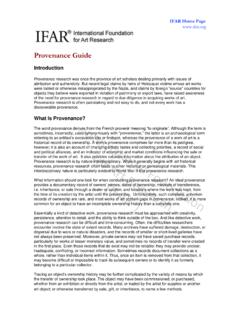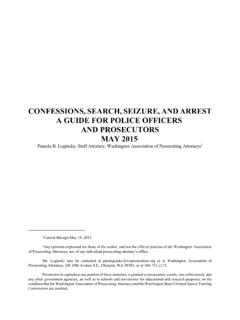Transcription of Chemical Segregation and Storage Guide
1 Chemical Segregation and Storage Guide This resource developed by LabCentral for the Pagliuca Harvard Life Lab Revision 1, Effective Dec 13, 2016 Chemical Segregation and Storage Guide 2016 Page 2 of 9 Table of Contents PURPOSE AND SCOPE ..3 CLASSES OF CHEMICALS ..3 Flammable liquids .. 3 Flammable solids .. 4 Corrosives .. 4 4 Water reactives .. 5 Peroxide formers .. 5 Compressed gases .. 5 Storage GROUPS ..5 Incompatibility .. 6 Storage AND Segregation METHODS ..6 General guidelines .. 6 Flammable liquids/solids and peroxide-forming chemicals.
2 7 Corrosive acids and bases .. 7 Water-reactives and Pyrophorics .. 8 8 Compressed gases .. 8 Explosives .. 9 Segregation pictograms .. 9 REVISION HISTORY ..9 Chemical Segregation and Storage Guide 2016 Page 3 of 9 PURPOSE AND SCOPE The proper Segregation and Storage of chemicals is a necessity for any laboratory in which hazardous chemicals are used. Accidental mixing of incompatible chemicals may cause fires, explosions or the production of toxic gases. The purpose of this Guide document is to provide a standardized plan for Chemical Segregation and Storage to protect Life Lab members and staff against potential hazards from incompatible Chemical reactions.
3 This Storage Guide should be used by Life Lab staff and members when establishing their respective Chemical Storage areas in the co-working lab as well as private suite, as well as any time new material is ordered. Parts of this Chemical Segregation and Storage Guide have been adapted from Chapman and Boston Universities Chemical Storage and Segregation guides. CLASSES OF CHEMICALS Flammable liquids Flammable liquids are liquids that will ignite easily and burn rapidly. More precisely, they are liquids with flash points that do not exceed 100 F ( C).
4 Less flammable liquids with flash points at 100 F or higher are categorized as combustible liquids. For Storage purposes, flammable and combustible liquids are considered to be part of the same category. Flammable and combustible liquids are further subdivided, depending on the liquid s flash point and boiling point. Table 1: Classes of Flammable and Combustible Liquids Class Flash Point Boiling Point Exceptions Class IA Flammable Liquids < 73 F ( C) < 100 F ( C) Class IB Flammable Liquids < 73 F ( C) 100 F ( C) Class IC Flammable Liquids 73 F ( C) and < 100 F ( C) < 100 F ( C) Class II Combustible Liquids 100 F ( C) and < 140 F (60 C) < 140 F (60 C) Any mixture having components with flash points 200 F ( C) is considered to be Class IIIB Class IIIA Combustible Liquids 140 F (60 C) and < 200 F ( C)
5 N/A Any mixture having components with flash points 200 F ( C), the total volume of which make up 99% or more of the total volume of the mixture is considered to be Class IIIB Class IIIB Combustible Liquids 200 F ( C) N/A Chemical Segregation and Storage Guide 2016 Page 4 of 9 Common Chemical examples: ethanol, methanol, acetone, xylene, toluene, TEMED; diethyl ether and tetrahydrofuran are flammable liquids as well as peroxide formers. Flammable solids Any material or Chemical , which in solid state can readily undergo combustion in the presence of a source of ignition ( large quantities of heat, light, gases) under normal pressure and temperature, is considered to be a flammable solid.
6 Certain flammable solids are also pyrophoric which means that the material, even in small quantities, is able to ignite or self-combust within five (5) minutes after coming in contact with air at or below 55 F. Common Chemical examples: carbon, charcoal, paraformaldehyde Corrosives Corrosive chemicals are highly reactive substances that cause obvious damage to living tissue. Corrosives act either directly by chemically destroying the part (through oxidation), or indirectly by causing inflammation. Corrosives can be either acidic or basic, and are sometimes referred to as caustics.
7 They can also be of organic or inorganic nature and exist in any state of matter: solid, liquid, gas, mist and vapor. Common Chemical examples: Inorganic acids hydrochloric acid, sulfuric acid, phosphoric acid, chromic acid, nitric acid Organic acids acetic acid, trichloroacetic acid, formic acid Inorganic bases ammonium hydroxide, potassium hydroxide, sodium hydroxide Organic bases ethanolamine, hydroxylamine, tetramethylethylamine, diamine, triethylamine Oxidizers Oxidizers are chemicals that initiate or promote combustion in other materials, causing fire either of itself or through the release of oxygen or other gases to a substrate.
8 Oxidizers are incompatible with most materials, especially flammables, combustibles and mineral materials. Common Chemical examples: Inorganic nitrates, nitrites, permanganates, chlorates, perchlorates, iodates, periodates, persulfates, chromates, hypochlorites, peroxides, perborates (such as nitric acid, perchloric acid, hydrogen peroxide, ammonium persulfate, sodium hypochlorite (bleach), sodium peroxide) Chemical Segregation and Storage Guide 2016 Page 5 of 9 Water reactives Water reactive chemicals are those that react vigorously with water, steam and moisture in the air to produce a flammable gas and heat.
9 The most common water sensitive chemicals include sodium, potassium, lithium metals and aluminum alkyls. Many water reactive chemicals may also be corrosive, toxic or pyrophoric. Common Chemical examples: sodium, lithium, and potassium metals, sodium borohydride Peroxide formers Commonly used organic solvents can undergo auto-oxidation under normal Storage conditions to produce peroxides. Peroxides are a class of Chemical compounds with unusual stability problems. They are sensitive to a varying degree to shock, heat, light or friction and may cause unexpected explosion of peroxidized organic chemicals.
10 Common classes of compounds that form peroxides include ethers, aldehydes, compounds containing benzylic hydrogens and compounds containing allylic hydrogens. Common Chemical examples: diethyl ether, tetrahydrofuran Compressed gases A compressed gas is a containerized gas or mixture of gases having an absolute pressure exceeding 40 pounds per square inch (PSI) at 70 F; a containerized gas or mixture of gases having an absolute pressure exceeding 104 PSI at 130 F regardless of the pressure at 70 F; or a liquid having a vapor pressure exceeding 40 PSI at 100 F as determined by ASTM D-323-72.








